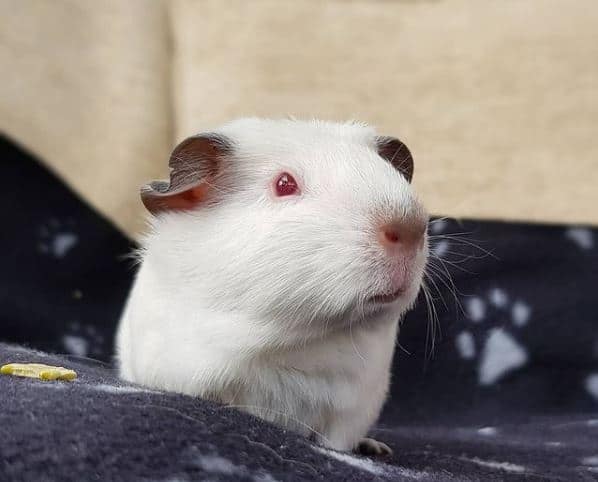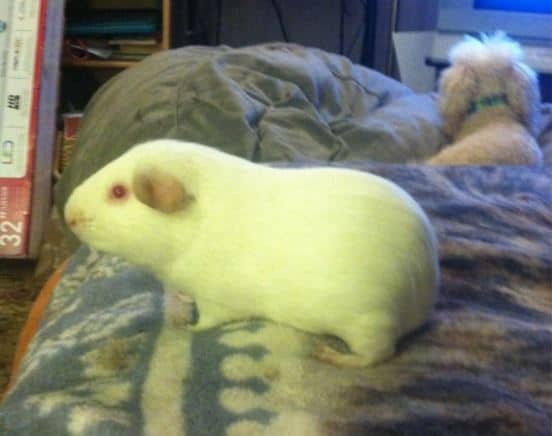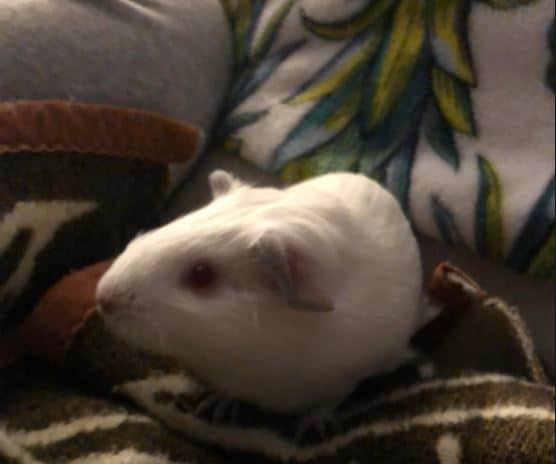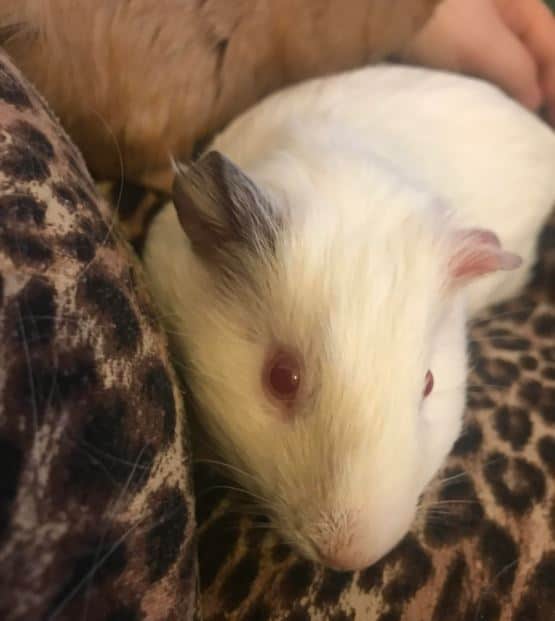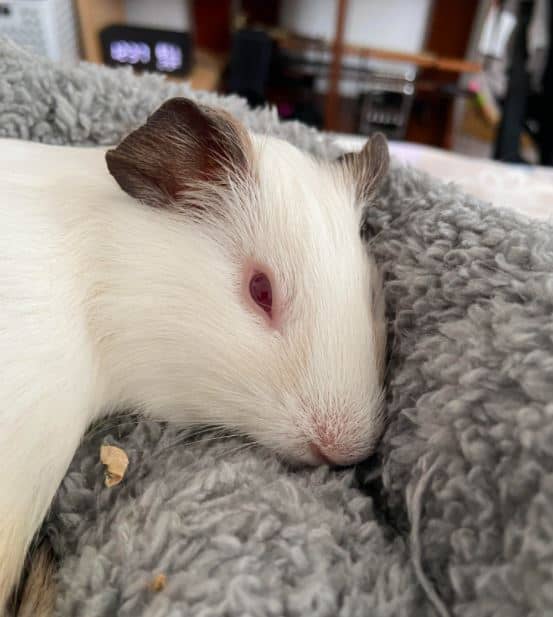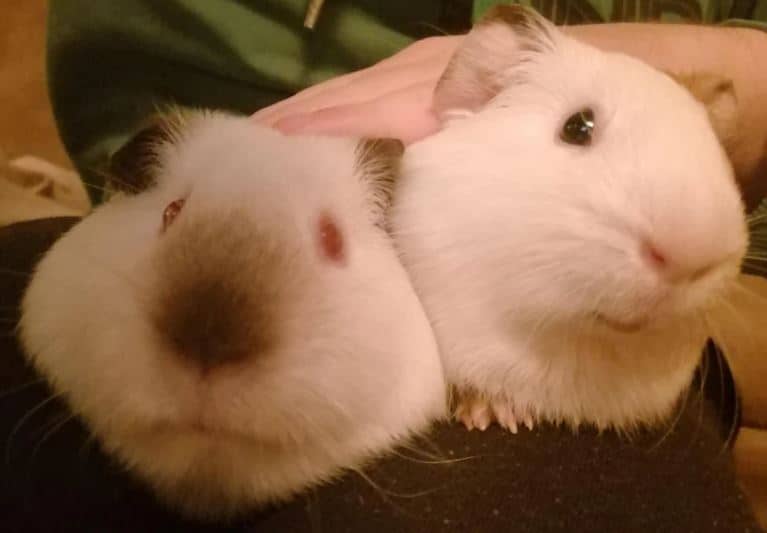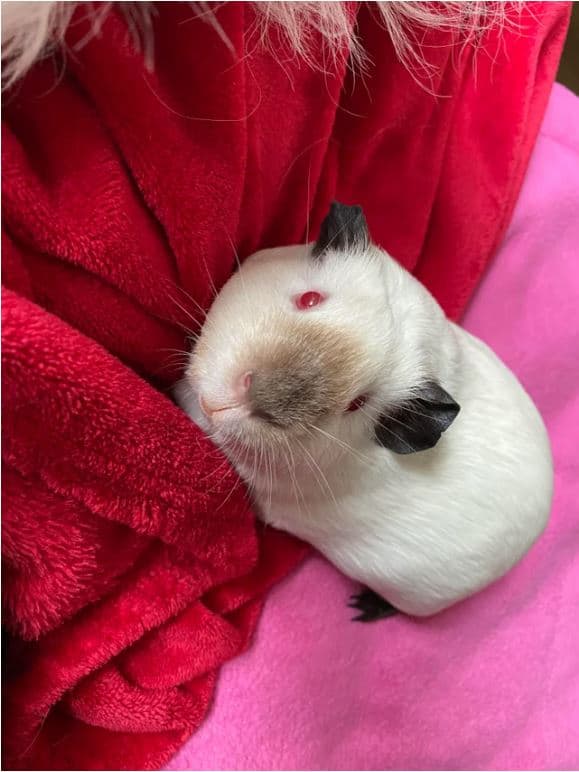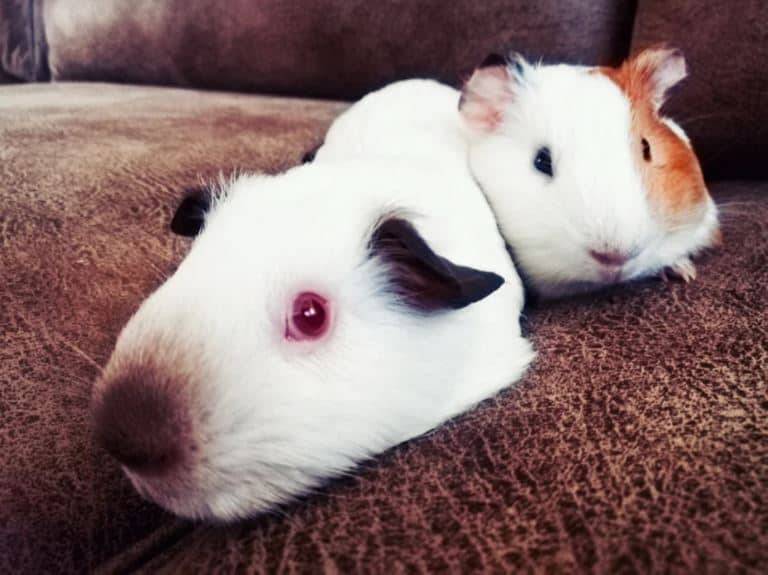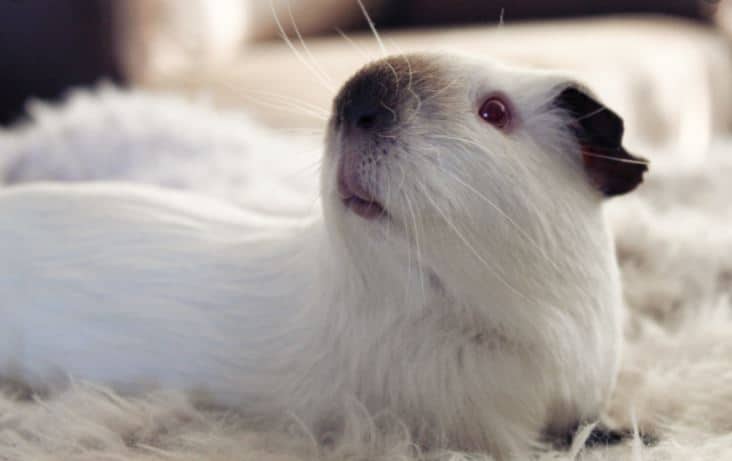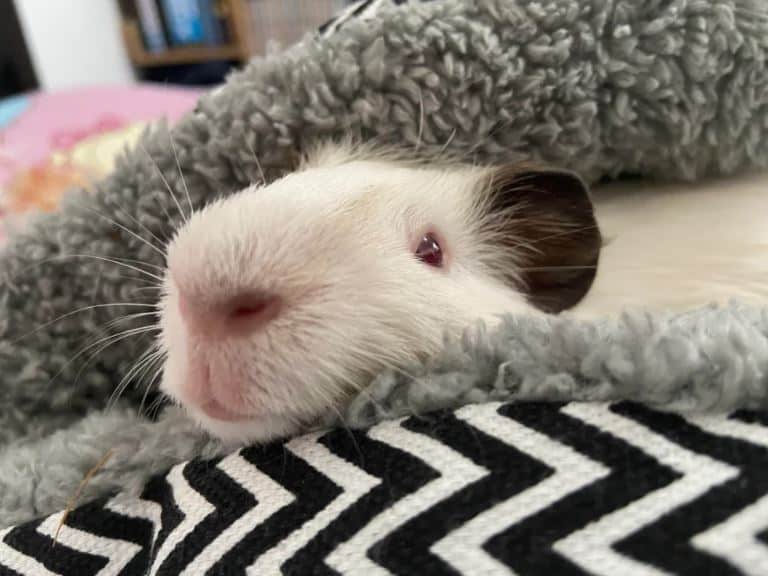The Himalayan guinea pig is a short-haired guinea pig breed. This breed stands out from the rest because of its white coat and red eyes, which gives this breed a distinct albino appearance. The Himalayan guinea pig is often born completely white but when they’re around 3 weeks old they start developing some color on their nose, feet, and ears. These markings are often dark in color and are not fully complete until the guinea pig is around 3 months old.
The Himalayan is known for being a sweet, calm, and loving breed which makes it a favorite among guinea pig lovers.
Guinea pigs are great pets, ask anyone who’s ever owned one. They’re smart, playful, affectionate, and very good with children. However, while deciding that you want a guinea pig as your new pet is easy, deciding which breed you want can be more difficult. There are many different breeds out there, all with their own distinct looks, personalities, histories, and care requirements. For that reason, we’re putting the Himalayan guinea pig in the spotlight to highlight everything you need to know about this beautiful breed so that you can make an informed decision on whether this breed is right for you.

Himalayan Guinea Pig History
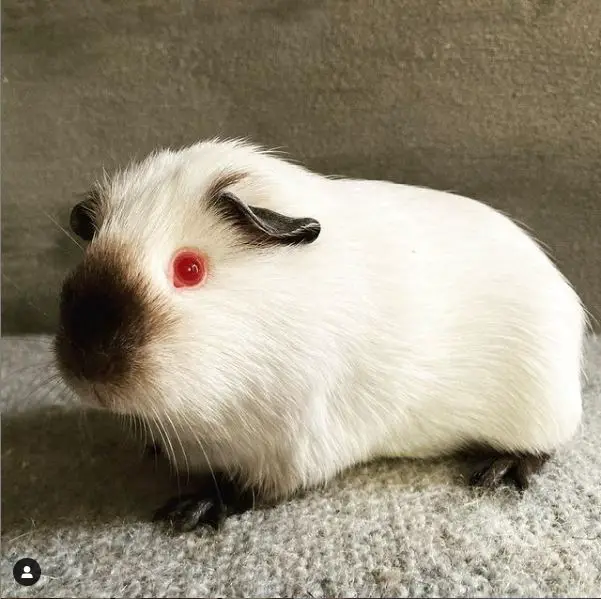
Despite its name, the Himalayan guinea pig does not actually come from the Himalayas in Asia. Instead, they originated in the Andes in South America where they lived in grassy plains and forest edges.
Instead, they most likely got their name due to how closely they resemble the Siamese cat, which is from Southeast Asia.
Unfortunately, not much else is known about the history of this breed. With some other breeds, such as the Texel or the Lunkarya, it’s quite clear where the breed comes from and how it came into existence but this is not the case for the Himalayan; its origins remain largely a mystery.
What is a Himalayan Guinea Pig?
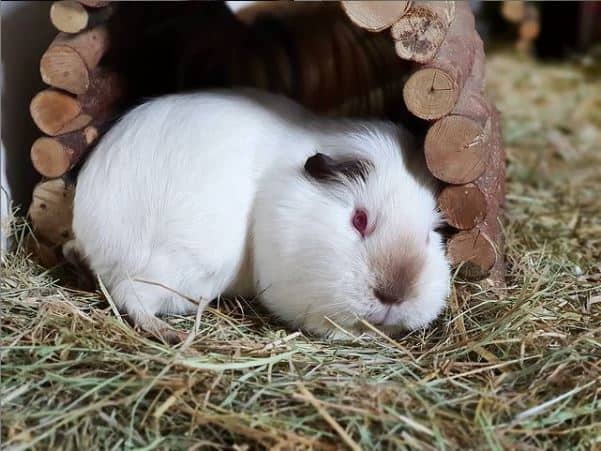
The Himalayan guinea pig is a distinct, short-haired, guinea pig breed of about 8 to 12 inches in length with broad shoulders and a thick build. Females typically weigh between 1.5 to 2 pounds, while males weigh between 2 to 2.6 pounds. The Himalayan stands out because it’s very different in appearance from other breeds. Whereas most guinea pig breeds have at least one other breed that they resemble quite closely, this is not the case for the Himalayan. The Himalayan is unique in the fact that it has red eyes and a mostly white coat with darker markings on the ears, feet, and nose. Because of this albino-like appearance they’re very easily distinguished from other breeds.
An interesting fact about the Himalayan guinea pig that not many people know is that the degree of darkness of the markings they develop as they grow older depends on temperature. If they’re kept in colder temperatures the markings will be darker, while in warmer temperatures the markings will be less dark. This is because the dark markings allow them to retain heat better, which is useful in cold climates.
The breed is officially recognized by the American Cavy Breeders’ Association and the British Cavy Council.
Himalayan Guinea Pig Traits
The Himalayan Guinea Pig’s personality and temperament are very favorable for a pet. They’re very receptive towards humans and love being petted, handled, and are quite easy to train. You can easily teach your Himalaya tricks like jumping, spinning, giving a high-five, and they’re even capable of solving some relatively complex mazes.
Furthermore, they generally get along well with other guinea pigs and love companionship. Guinea pigs are social animals. In the wild, they roam in large herds on the grassy plains of the Andes. Because of this, they’ve naturally evolved to desire the company of other guinea pigs. A lone Himalayan will not be happy. Make sure that you get at least a pair of guinea pigs, never keep a guinea pig in solitude. No matter how much time and love you give your piggy, they always need a companion of the same species as well.
Are Himalayan Guinea Pigs expensive?
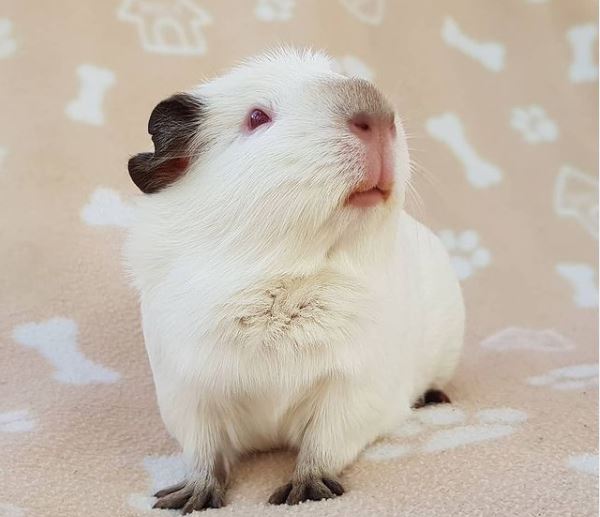
Himalayan guinea pigs are quite a rare breed. Because of this, they’re relatively expensive. Finding a Himalayan guinea pig for sale can prove to be quite difficult. Your best bet is trying to find a local breeder.
If you cannot find a local breeder, adopting one is also a good option. Sites like Petfinder and guineapigfinder can help with this.
Care
Now that you know about where the Himalayan guinea pig comes from and its behavior, it’s time to learn a little bit more about how to properly care for it. This includes grooming, its diet, and any health issues it might have, and how to prevent them.
Grooming
Himalaya guinea pigs are a short-haired breed. Because of this, grooming them is much easier than some other breeds such as the Sheltie. According to Omlet: “A lot of the grooming of short-haired guinea pigs is done by the guinea pig itself, or by their guinea pig friends. All that needs to be done by their owners is a cleaning of the grease gland, a regular bath, and a brief brush through every so often in the direction in which their hair grows”
Diet
The diet of the Himalayan Guinea pig is no different than that of any other breed. To sum it up quickly, this is what they need:
- An unlimited amount of Timothy hay.
Timothy hay is essential for guinea pigs because it allows them to grind down their teeth and it aids their digestion. Make sure that they always have access to this so that they can eat as much of it as they desire. - Fresh vegetables.
According to veterinarians at the Small Animal Hospital, about 20% of your guinea pig’s daily food intake (by weight) should consist of fresh vegetables. This comes down to about a cup of fresh veggies per guinea pig per day. The majority of these veggies should be leafy greens (kale, cabbage, romaine lettuce, etc) with a smaller amount being colored vegetables such as carrots. - Fruits & treats.
Fruits are good for your guinea pig in small quantities. Fruits should not be a large part of their diet but should be considered a treat. Make sure that no more than 10% of their food intake consists of fruits or treats. - Water.
In order to stay healthy, you have to make sure that your cavy has access to plenty of fresh water from their water bottle at all times. Make sure to rinse their bottle and replace the water often.
Health
Himalayan guinea pigs are generally healthy breeds. They’re not particularly prone to disease. Nevertheless, they can still get sick. The most important thing to do to ensure that your Himalayan stays healthy is to supplement their diet with vitamin C.
Just like humans, guinea pigs are incapable of creating vitamin C, so they need to get it from their diet. According to veterinarians, if they do not get enough vitamin C it can lead to scurvy, weight loss, lethargy, a rough coat, diarrhea, or even internal bleeding. If you notice these symptoms, take your guinea pig to a vet asap.
Oftentimes, the average guinea pig does not get enough vitamin C from their diet which is why many pet owners choose to supplement their piggy’s diet with additional vitamin C.
Also, make sure that you take your Himalayan for regular vet checkups.
Housing
The cage that you put your Himalayan Guinea pig in should be large enough, have bedding, toys, and a sheltered area where they can sleep.
The recommended minimum cage size for two Himalayan Guinea pigs is 7.5 square feet (minimum), but 10.5 square feet is preferred; generally, 30 inches x 50 inches is a good size, but bigger is always better. The toys they like are chew toys, tunnels, hammocks, and playpens.
As for bedding, avoid cedar and pine bedding because it can cause irritation to your piggy’s skin. It’s best to go with specialized guinea pig bedding such as this.

Final words + picture gallery!
So, now you know everything there’s to know about the Himalayan guinea pig! I hope this overview was helpful and that it gave you the information you need to decide whether or not this breed is right for you.
To give your eyes some rest from all this reading, here’s a picture gallery of some beautiful Himalayan guinea pigs.
- How Long Do American Eskimo Dogs Live? Important Factors and Care Tips - September 29, 2023
- Do American Bulldogs Need Grooming? Essential Tips and Care Guidelines - September 29, 2023
- Do Bengal Cats Enjoy Playing? Essential Tips for Keeping Them Active - September 29, 2023
